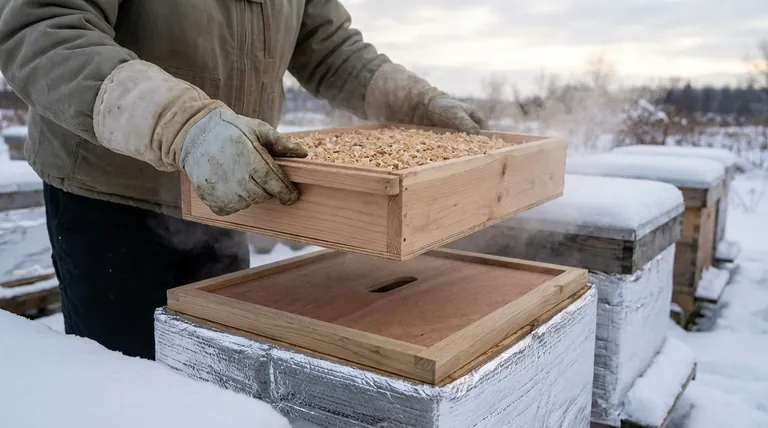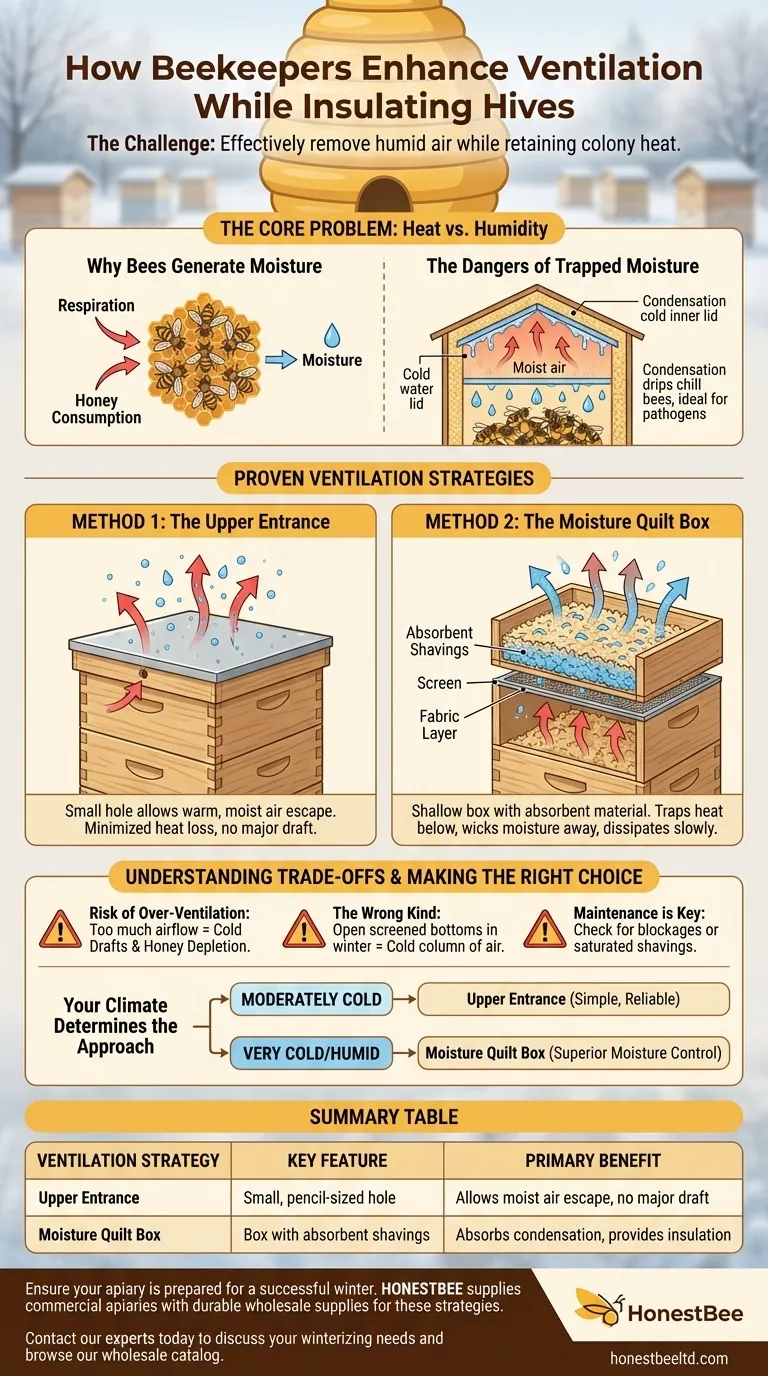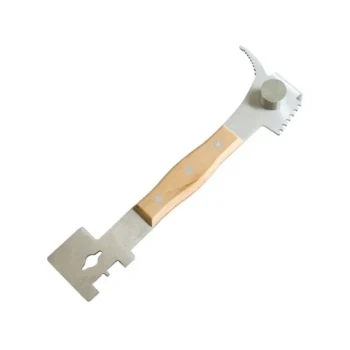To effectively winterize a beehive, you must enhance ventilation while insulating, not in spite of it. Beekeepers achieve this by using specific setups like a small upper entrance or a moisture quilt box. These methods allow the warm, moist air generated by the bees to escape without creating a cold draft, thus preventing condensation and keeping the colony both warm and dry.
The central challenge of wintering bees isn't just keeping them warm; it's managing the moisture they produce. Effective wintering requires a system that actively removes humid air while retaining the colony's metabolic heat.

The Core Problem: Heat vs. Humidity
To solve the ventilation puzzle, you must first understand the forces at play inside a winter hive. The bees are working to survive, and their activity creates an internal atmosphere that can be either helpful or harmful.
Why Bees Generate Moisture
A honey bee cluster produces significant moisture in two ways. First, like all living animals, they release water vapor through respiration. Second, moisture evaporates from the uncapped honey they consume for energy.
The Dangers of Trapped Moisture
Without an escape route, this warm, moist air rises and hits the cold inner cover or top of the hive. It then condenses into water droplets. This cold water can drip back down onto the cluster, chilling the bees and creating damp conditions that are ideal for pathogens like Nosema.
How Insulation Complicates Things
Insulation is critical for reducing heat loss and helping the bees use less energy. However, by wrapping the hive, you can inadvertently trap the moist air inside. A well-insulated but poorly ventilated hive becomes a damp, cold trap. Proper ventilation works with insulation to create a healthy microclimate.
Proven Ventilation Strategies for Insulated Hives
The goal is to create a "chimney effect" where warm, moist air can rise and exit naturally. Here are the two most reliable methods to achieve this.
Method 1: The Upper Entrance
This is the simplest and most common technique. It involves creating a small hole, about the diameter of a pencil, in the uppermost hive box.
Warm, moist air, being lighter than cold air, rises and exits through this small opening. Because the hole is small, it allows moisture to escape without creating a significant draft or losing too much heat.
Method 2: The Moisture Quilt Box
A moisture quilt box (also known as a Vivaldi board) is a more advanced and highly effective system for moisture control. It is a shallow box placed on top of the hive, directly above the bee cluster.
The bottom of the box is a screen, and the box is filled with an absorbent, insulating material like untreated wood shavings. A fabric layer (like canvas) is often placed between the bees and the screen to prevent them from chewing on the shavings.
Warm, moist air rises through the screen and into the shavings, which absorb the moisture. The shavings provide an insulating layer, trapping heat below while wicking the condensation away from the bees. The moisture can then slowly dissipate through ventilation holes in the sides of the quilt box or through a slightly offset outer cover.
Understanding the Trade-offs
Implementing ventilation is a balancing act. Missteps can undermine your efforts and create new problems for the colony.
Risk of Over-Ventilation
A common mistake is creating too much ventilation. A large upper entrance or excessive gaps can create a cold draft. This forces the bees to consume more honey stores to generate heat, potentially leading to starvation. The opening should be just large enough to let moisture out.
The Wrong Kind of Ventilation
While a screened bottom board is excellent for summer ventilation, leaving it wide open in a cold climate can be detrimental. It creates a column of cold air directly beneath the cluster, defeating the purpose of insulation and forcing the bees to work harder to stay warm. Top ventilation is the standard for wintering.
Maintenance is Key
Ventilation systems are not "set and forget." An upper entrance can become blocked by snow, ice, or dead bees. A moisture quilt's shavings can become saturated with water over a long, damp winter and may need to be replaced with dry material.
Making the Right Choice for Your Goal
Your local climate and management style will determine the best approach.
- If your primary focus is simplicity and you are in a moderately cold climate: A small, drilled upper entrance is a reliable and easy-to-implement strategy.
- If your primary focus is maximum moisture control in a very cold or humid climate: A moisture quilt box offers superior performance by absorbing condensation before it becomes a problem.
- If you are experimenting with maximum insulation: Combine your insulation wrap with a minimal upper entrance and monitor the inside of the lid for any signs of condensation, adjusting as needed.
By actively managing both heat and moisture, you create a stable environment that allows your colony to thrive through the winter.
Summary Table:
| Ventilation Strategy | Key Feature | Primary Benefit |
|---|---|---|
| Upper Entrance | Small, pencil-sized hole in top box | Allows warm, moist air to escape without a major draft |
| Moisture Quilt Box | Shallow box filled with absorbent wood shavings | Absorbs condensation, provides insulation, and wicks moisture away |
Ensure your apiary is prepared for a successful winter. HONESTBEE supplies commercial apiaries and beekeeping equipment distributors with the durable, wholesale-focused supplies needed to implement these ventilation strategies effectively. From quilt box components to precision tools, our equipment helps you maintain healthy, productive colonies. Contact our experts today to discuss your winterizing needs and browse our wholesale catalog.
Visual Guide

Related Products
- Inner Beehive Cover for Beekeeping Bee Hive Inner Cover
- Professional Insulated Winter Hive Wrap for Beekeeping
- Professional Galvanized Hive Strap with Secure Locking Buckle for Beekeeping
- Long Langstroth Style Horizontal Top Bar Hive for Wholesale
- Multi-Function Hive Tool with Integrated Hammer for Beekeeping
People Also Ask
- What is the function of the center hole in the inner cover? Master Hive Ventilation and Feeding
- What are the advantages of using an inner cover in a beehive? Key Benefits for Hive Health & Beekeeper Efficiency
- What is the function of an inner cover in a beehive? Essential for Hive Health & Management
- Why might beekeepers use an inner cover under the telescoping outer cover? Simplify Hive Management & Protect Your Colony
- What is the purpose of the inner cover in a beehive? A Key to Hive Health & Easy Management



















